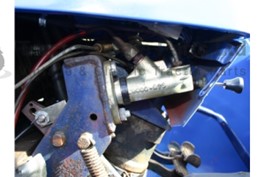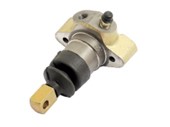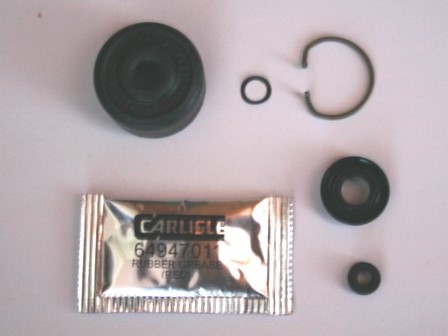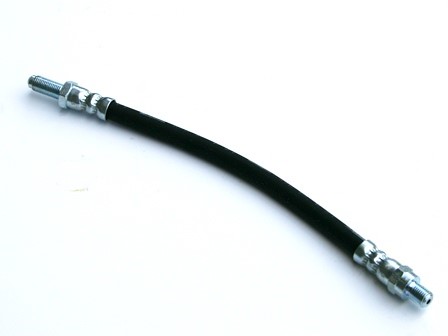And here we are, in Part 3 of the blogs about the braking systems of the Leyland middleweight tractors. When I set out with this blog topic, I never thought it would go over to 3 blogs worth of information. I know I have said it before, and I will say it again, brakes are SO IMPORTANT! Maybe that is why I feel that I do not want to skip the information and make it shorter.
So, if you are still with me on this epic journey through the different braking systems, then well done. I hope it will impart some useful information, or even just bring the brakes on your Leyland back to the front of your mind.
Master and Slave Cylinder
So the cylinders on the braking system are split into 2 section – the slave cylinder and the master cylinder. There are two of each of the middleweight Leyland tractor braking system; although you could say that there are 3 of the master cylinders as it is the same on the clutch system (with the slave cylinder being different on the clutch system).
Master Cylinder
The master cylinder, part number CTJ5430, is located in the cab and attaches directly to the brake pedals. The job of the master cylinder is to transfer the hydraulic pressure in the brake fluid generated by the pressing of the brake pedal. This in turn sends the brake fluid to the slave cylinder which expands and results in the application of the brakes.

Slave Cylinder
The brake slave cylinder is located underneath the cab and next to the axle. So there is one each side of the tractor.

The slave cylinders that we offer, part number NTT35, are actually the same brake slave cylinders as used on the Marshall tractors with the wet braking systems. However, to convert it for use with the Leyland dry brake systems you need a banjo bolt , part number AAU2159, as this is different to the original types on the Leyland (it is 3/8” on the Marshall slave cylinders as opposed to 7/16” on the original Leyland slave cylinders, which are no longer available).
New Cylinder or Seal Kits?
This is the ultimate question, and I wish that I could recommend seal kits all the time as they are so much cheaper than the brand new cylinders. The seal kits cost about £12-£15 each, whereas new cylinders cost £80-£90 each – so there is quite a significant difference.
The difficulty comes because if you try a seal kit and they do not work, then it is a waste of £15, and you have to buy a new cylinder anyway.

The cylinders will reseal as long as there is no rusting or pitting of the inside of the bore of the cylinder. In Part 2 of this blog series, we talked about how the Dot 4 fluid is hygroscopic so it absorbs water from the air. Well, this water sits in the bottom of the cylinders and causes corrosion of the metal bore. This pitting means that the seals will not work, and you will need to buy a new cylinder.
So I guess if you have time, the ideal solution would be to take the cylinder apart and look and feel inside the bore for corrosion prior to purchasing the parts. But life does not always work that way, and sometimes we just have to make an educated guess.
Brake Fluid Pipes
Another thing that is worth checking on the Leyland tractors, is the flexible hose that fits between the cylinder and the metal pipes, which is part number AAU5140.

This flexible pipe is rubber, and therefore it is likely to perish as the seals in the slave and master cylinders does. As discussed in Part 2 of this blog, the wrong brake fluid will cause the rubber and seals to swell. Because the brake pipe is so flexible, the small hole in the middle of the pipe can sometimes become blocked. So, we always ask customers to check that their flexible brake pipes can pass air down them to see if fluid can pass easily though the pipe. If no air can pass through, then fluid will not be able to pass either, so the pipes will need replacing.
As we have talked about water being absorbed by the brake fluid, we know that this can cause corrosion from the inside of brake pipes, so it is always worth keeping an eye on the metal brake fluid pipes in the braking system. Even though corrosion cannot always be seen from the outside, weeps and drips can be a sign that they need replacing.
So, Do Leyland Brake Deserve The Bad Reputation That They Have?
This was the ultimate question that I set out to answer in this series of blogs, and three blogs later, I have given you a bit of an insight into the things that you need to watch out for with Leyland brakes.
With regular maintenance, and careful set-up, the brakes can be more than sufficient for the tractor. They will never be as good as a wet braking system, but for the weight of the tractor and the load that it should be carrying then it should be good enough. As with any vintage or classic vehicle, consideration should always be taken while driving these vehicles as they are not like modern vehicles. You should not drive a Leyland tractor like a modern tractor in any way. They are classics to be loved and cherished, but they can still put in a good days work and should be able to bring you to a stop at the end of the day as long as you pay attention and care for them.
I Have So Much More To Say, But I Have Gone On For Long Enough
Of course, this has not been an exhaustive list of things that you can find wrong with the brakes on a Leyland middleweight tractor. There are always curveballs that these vehicles throw, and we have a seen a lot of them over the years. So, if you are struggling, or just want to speak to somebody about your Leyland brakes, do not hesitate to get in touch and we can help you decide which might be the best things to try first. We won’t stop until you are happy with the brakes on your blue Leyland.





